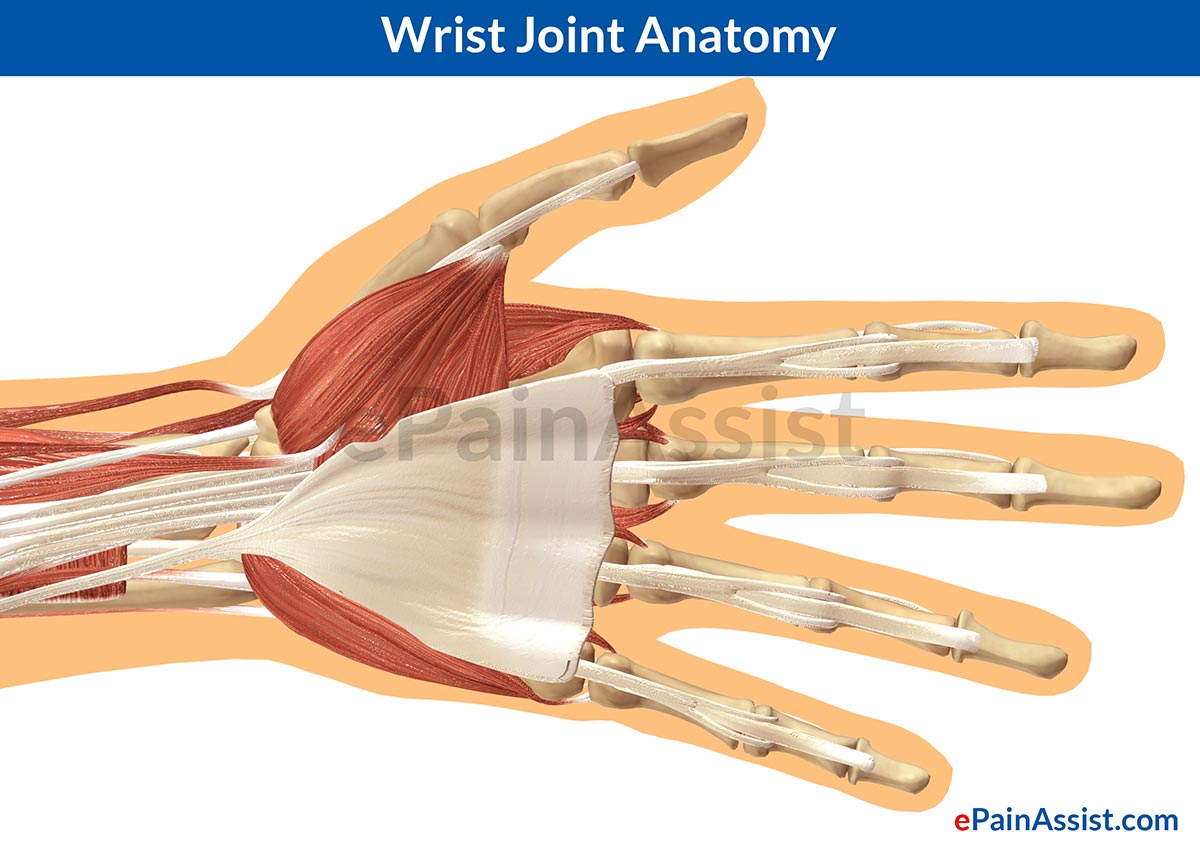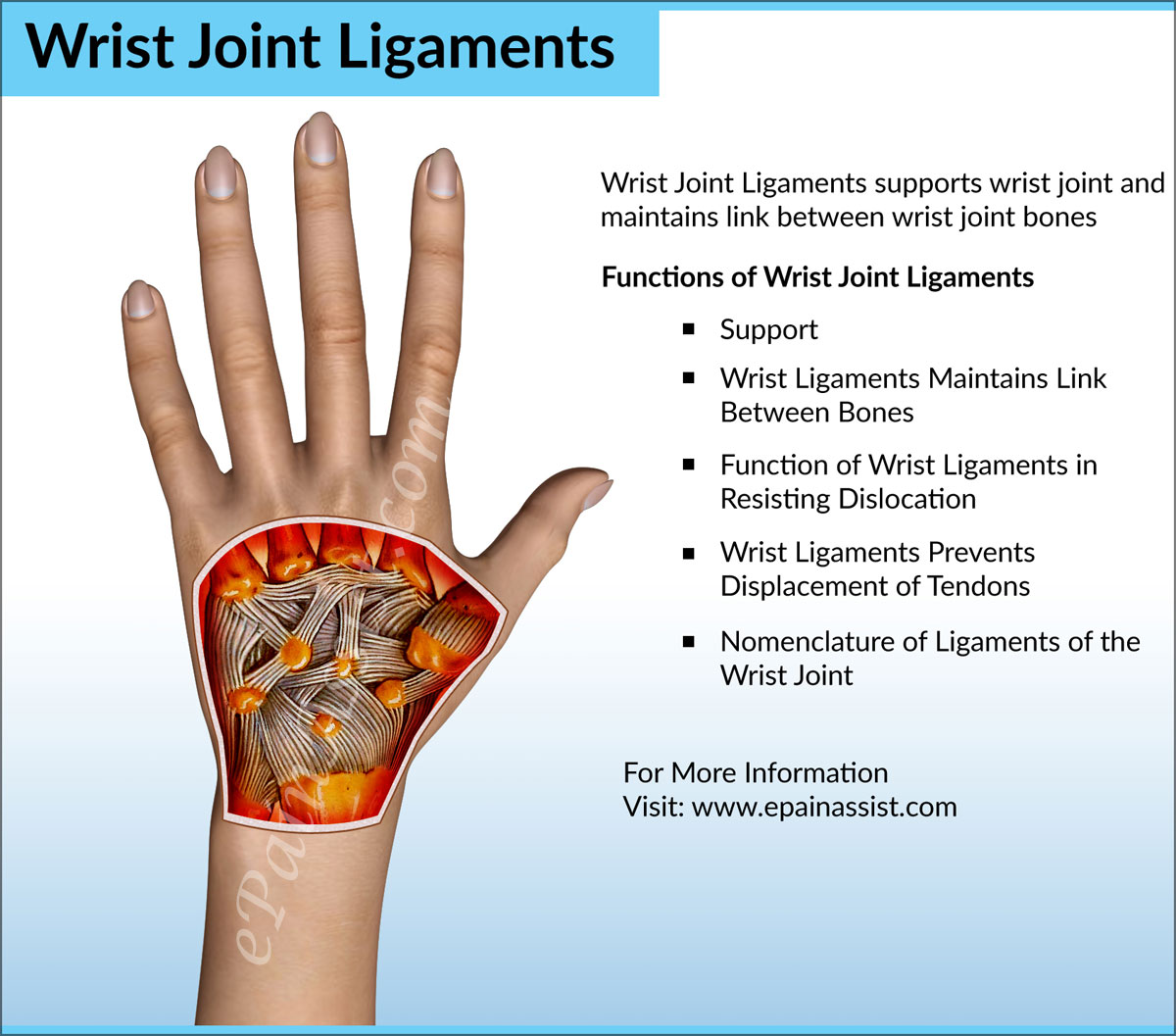Wrist joint supports movement of hand and forearm. Sports and manual work involves complicated and coordinated activities of the hand and wrist joint. Wrist joint is second most active joint after ankle joint. Wrist joint is a perfect geometrical pattern that matches convex shape of carpal bones with concave articulating surface of radius. Ulnar bone is not in contact with carpal bone at rest, but during supination and pronation, the carpal bone gets linked to ulna to optimize the rotation.
Bones of Wrist Joint
Wrist joint is a flexible joint and involves 15 bones in forming three sections of wrist Joint.
The Three Sections of the Wrist Joint Are As Follows-
Proximal Wrist Joint– Proximal wrist joint is a pivot joint formed by radius and ulna. Head of distal end of ulna lies against ulnar notch of radius bone. The link between ulna and radius is covered with smooth cartilages. Joint is covered by synovial capsule. Capsule is lax around the joint which allows semi-rotation of joint during pronation and supination.
Intermediate Wrist Joint- Intermediate Wrist Joint Forms Two Links As Follows-
- First link is between Radius and Ulna with proximal row of 3 carpal bones. The three carpal bones of proximal row are Scaphoid, Lunate and Triquetrum. The joint is also known as ellipsoid joint. Distal end of Ulna comes in contact with Triquetrum during ulnar deviation or adduction movement of wrist joint.
- Second link is between proximal and distal row of carpal bones, also known as inter-carpal wrist joint. Trapezium, Trapezoid, Capitate, Hamate and Pisiform form distal rows of carpal bones and are linked with proximal 3 carpal bones to form intermediate wrist joint.
Distal Wrist Joint- Distal row of carpal bones Trapezium, Trapezoid, Capitate, Hamate and Pisiform are linked with five metacarpal bones.
Synovial Membrane Capsule- Synovial membrane is a thin connective tissue. Synovial membrane produces viscous lubricating fluid. Synovium covers all three sections of wrist joint. Lax synovial capsule allows following wrist joint movements.
Wrist Joint Movements
- Wrist Flexion Movement or Forward Bend of the Wrist Joint. Bending the palm downwards towards the wrist is called Wrist Flexion
- Wrist Extension Movement or Backward Bend of the Wrist Joint. Bending the palm upwards with fingers facing the sky is called Wrist Extension.
- Wrist Abduction Movement (Radial Deviation) or Sideward Bend of the Wrist Joint. Bending the wrist away from body on the side of the thumb while palm facing upward is called wrist abduction or radial deviation.
- Wrist Adduction Movement (Ulnar Deviation) or Sideward Bend of the Wrist Joint. Bending the wrist towards the body while palm is facing upward is called Wrist Adduction or Ulnar Deviation.
Wrist Joint Ligaments
There are several ligaments between Radius, Ulna, Carpal Bones and Metacarpals.
Functions of Wrist Joint Ligaments
- Support- Wrist Joint Ligaments supports wrist joint and maintains link between wrist joint bones.
- Wrist Ligaments Maintains Link Between Bones– Wrist joint ligament fastens adjacent bones linked to each other as a joint.
- Function of Wrist Ligaments in Resisting Dislocation- Wrist joint ligaments are tough fibrous tissue and resist dislocation of the wrist joint.
- Wrist Ligaments Prevents Displacement of Tendons- Nerves and Blood Vessels- Wrist ligaments located over palmer (front) and dorsal (back) surface of wrist joint are known as retinaculum. Retinaculum holds and prevents displacement of tendons, nerves and blood vessel.
- Nomenclature of Ligaments of the Wrist Joint- Ligaments are identified or named according to their attachment to two bones.
- Flexor Retinaculum- Flexor retinaculum lies on palmar side in front of wrist joint.
- Extensor Retinaculum- Extensor retinaculum lies on back of wrist.
- Functions of Wrist Joint Retinaculum-
- Retinaculum confines nerve, blood vessels and tendons against wrist joint.
- Retinaculum prevents bending or sliding of the tendon, nerve or blood vessels.
- Retinaculum prevents bowstring shape of tendon, blood vessels and nerve.
- Carpal Tunnel Syndrome- Hypertrophy or thickening of flexor retinaculum causes pinch of median nerves that results in symptoms like tingling, numbness, weakness in hand Carpal tunnel narrowing may cause ischemic changes in hand because of partial obstruction of blood flow to hand and fingers.
Tendons Supporting Wrist Joint-
Tendons are tough bundle of fibrous tissue that anchors muscles to joint and bones. Muscles end as a tendon. Muscle contraction pulls tendon toward the contracting muscles. Tendon pulls the joint or bone toward contracting muscles. Joint movements observed at wrist joint are flexion, extension, abduction and adduction.
Tendons Supporting Wrist Joint Movements-
Tendons and muscles supporting wrist joint movements are as follows-
Abduction (Radial Deviation) of Wrist Joint- Abduction is movement of the hand around wrist joint towards thumb while palm is facing to ceiling.
- Extensor Carpi Radialis Longus
- Abductor Pollucis Longus
- Flexor Pollucis Longus
- Flexor Carpi Radialis
- Flexor Pollucis Longus
Adduction (Ulnar Deviation) of Wrist Joint- Adduction is movement of the hand around wrist joint towards little finger while palm is facing to ceiling.
- Extensor Carpi Ulnaris
- Flexor Carpi Ulnaris
- Extensor Digitorium
- Extensor Digiti minimi
Flexion of Wrist Joint- Hand is tilted around wrist joint toward palmar surface of forearm.
- Flexor Pollucis Longus
- Flexor Digitorum Profundus
- Flexor Digitorum Superficealis
- Flexor Carpi Ulnaris
- Flexor Carpi Radialis
Extension of Wrist Joint- Hand is tilted around wrist joint toward dorsal surface or back of hand.
- Extensor Pollucis Longus
- Extensor Digitorum
- Extensor Carpi Radialis
- Extensor Carpi Brevis
- Extensor Indicis
- Extensor Carpi Radialis Longus
- Extensor Digiti Minimi
- Extensor Carpi Ulnaris
Pronation and Supination is rotation of forearm that involves minor rotation of radius over ulna.
- Radiopaedia: “Wrist Joint.” https://radiopaedia.org/articles/wrist-joint
- Stanford Children’s Health: “Wrist Joint Anatomy.” https://www.stanfordchildrens.org/en/topic/default?id=wrist-joint-anatomy-90-P02053
Also Read:
- Wrist Ganglion: Types, Causes, Symptoms, Treatment, Exercises
- Tendonitis Wrist or Wrist Tendinitis: Causes, Signs, Symptoms, Treatment, Exercises, Tests
- Wrist Pain: 9 Major Medical Conditions that Cause Wrist Pain orWrist Joint Pain
- Wrist Pain, Wrist Joint Pain: Symptoms, Treatment- Conservative, PT, Surgery, Prevention
- Wrist Joint Tendonitis: Causes, Symptoms, Treatment-Medications, PT, Surgery
- Wrist Joint Arthritis: Symptoms, Causes, Treatment- Medications, NSAIDs, PT, Surgery
- Wrist Joint Dislocation: Causes, Symptoms, Treatment- PT, Close Reduction, Surgery
- Treatment for Wrist Joint Pain: Conservative, Medications, PT, Surgery
- Wrist Joint Fracture: Types, Causes, Symptoms, Treatment- Medications, PT, Surgery
- Wrist Pain Information Center





